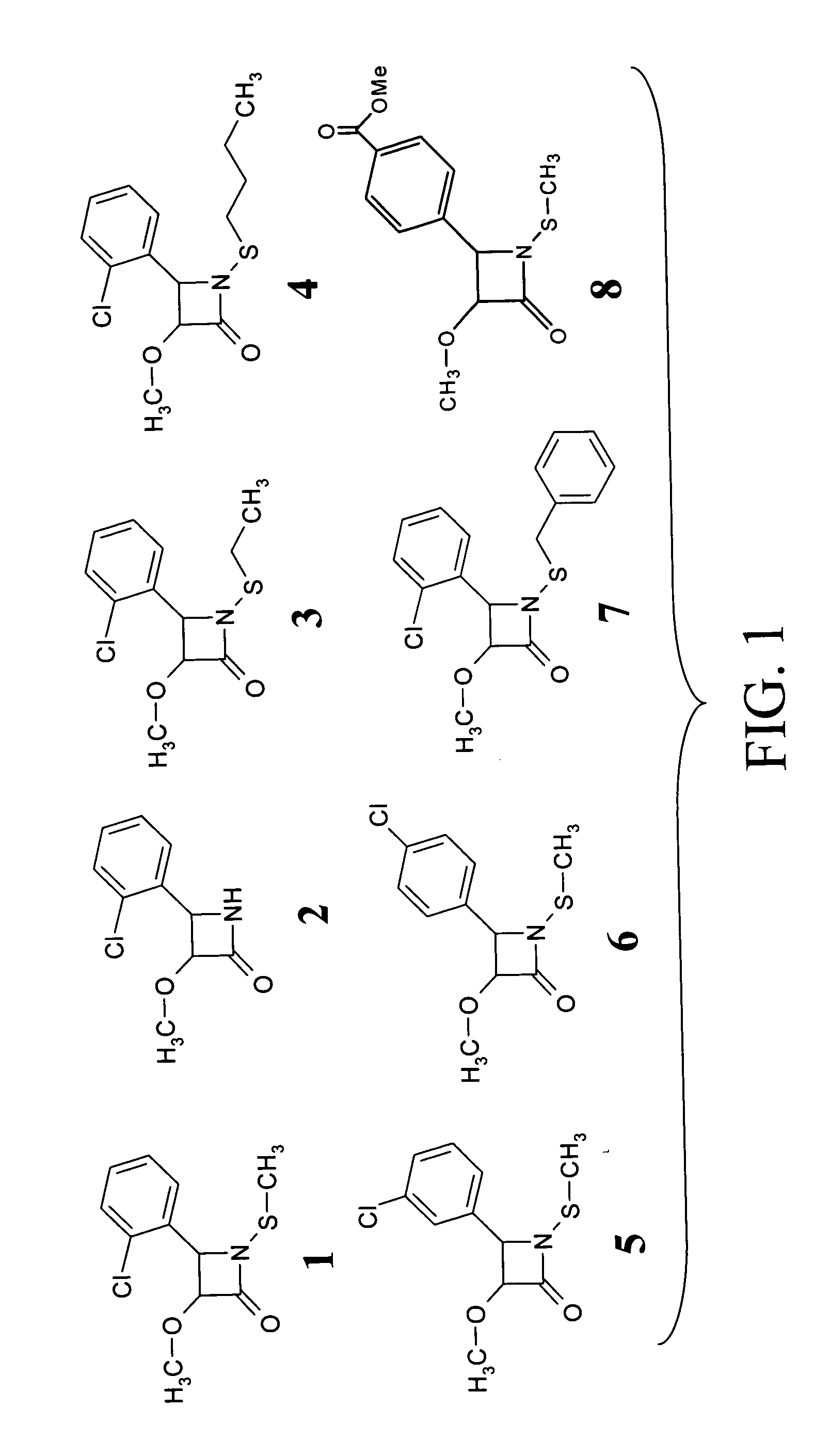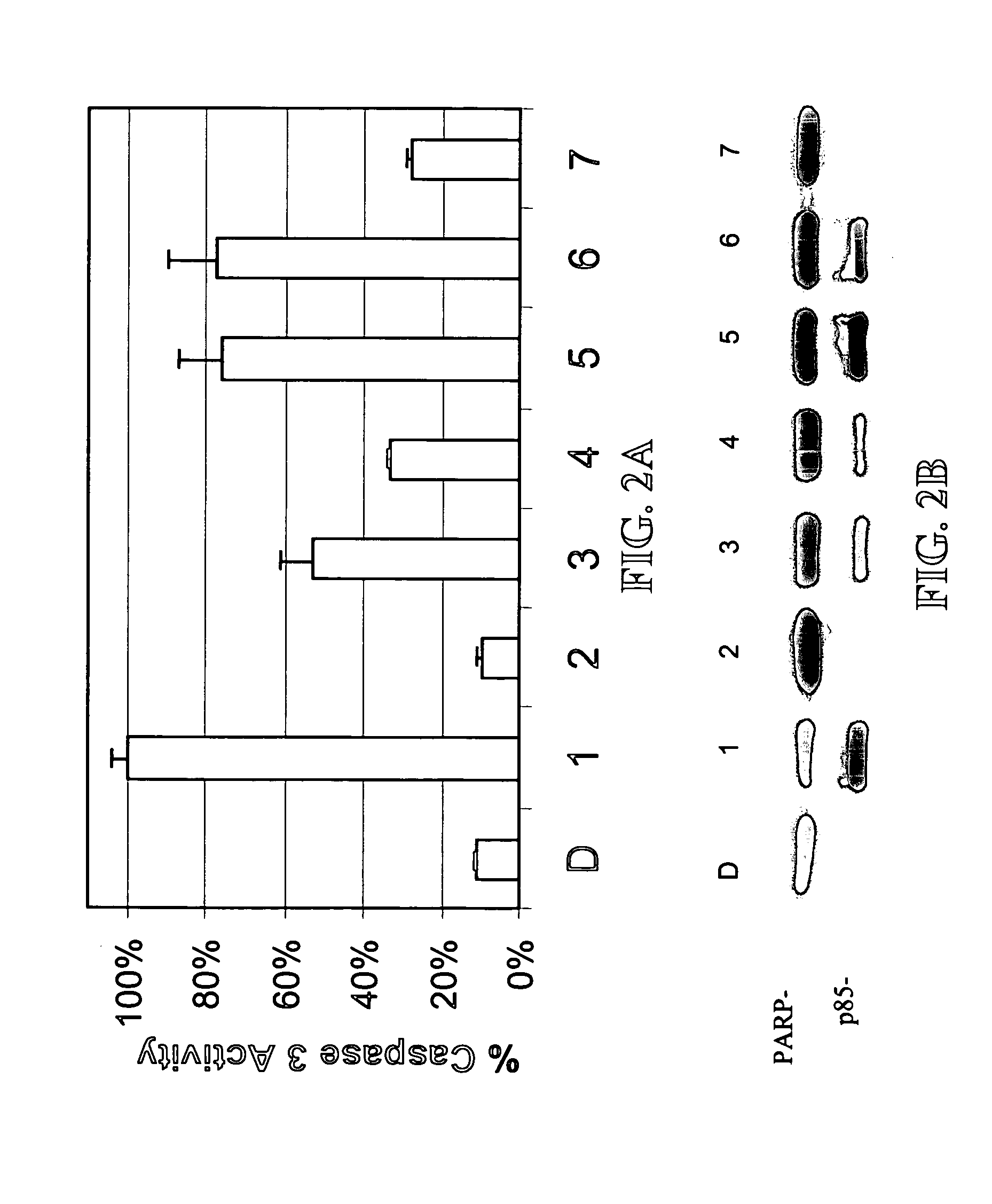Methods for preventing and treating cancer using N-thiolated beta-lactam compounds and analogs thereof
a technology of n-thiolated beta-lactam and compounds, which is applied in the field of n-thiolated beta-lactam compounds, analogs and derivatives, and can solve the problems that n-thiolated beta-lactam compounds have not found use as anticancer drugs
- Summary
- Abstract
- Description
- Claims
- Application Information
AI Technical Summary
Benefits of technology
Problems solved by technology
Method used
Image
Examples
example 1
Synthesis of N-Thiolated B-Lactam Compounds
[0105] N-thiolated β-lactam compounds can be synthesized as shown in the reaction scheme below. See: Staudinger, 1907, Liebigs Ann. Chem. 356:51, Georg et al., 1993, in: “The Organic Chemistry of β-lactams”, Verlag Chemie: New York, pp. 295-368.
Procedure for the Preparation of N-aryl Protected β-lactams
[0106] To a stirred solution of Et3N (1.25 mL, 9.0 mmol) and imine (7, R═CCPh) (1.88 g, 8.0 mmol) in CH2Cl2 (75 mL) at room temperature is added via cannula a solution of methoxyacetyl chloride (6, X═OMe) (0.91 g, 10.0 mmol) in CH2Cl2 (20 mL). The reaction mixture is stirred at room temperature for 30 min, poured into 5% aqueous HCl (75 mL), and extracted with CH2Cl2 (3×50 mL). The combined organic layers are dried over MgSO4, filtered, and evaporated to give a brown oil that slowly crystallizes upon standing. Flash chromatography (2:1 CH2Cl2:hexanes and then CH2Cl2) of the crude material affords 2.2 g (89%) of β-lactam (8, X═OMe, R═CCPh...
example 2
Screen for Apoptotically Active β-Lactams
[0120] A library of β-lactam analogs was screened for their ability to induce apoptosis. A representative group of 7 compounds and their structures is shown in FIG. 1. The screening procedure is accomplished by treating human Jurkat T cells with each compound at 50 μM for 8 hours. This is followed by preparation of cell lysates and measurement of apoptosis-specific caspase-3 activation (by cell-free caspase-3 activity assay) and PARP cleavage (by Western blotting).
[0121] Among the tested compounds, lactam 1 was found to have the greatest potency to induce caspase-3 activation and PARP cleavage within 8 hours of treatment (FIGS. 2A and 2B). Several important structure-activity relationships (SARs) were observed. First, the N-methylthio group is required for the apoptosis-inducing activity of lactam 1. Lactam 2, which is an analog of lactam 1 that lacks the N-methylthio group (FIG. 1), induces neither caspase-3 activation nor PARP cleavage (F...
example 3
Lactam 1-Induced Apoptosis is Caspase-Dependent and Associated with Cytochrome C Release
[0124] Lactam 1-induced apoptosis was studied by performing both kinetics and concentration-response experiments. When Jurkat T cells were treated with 50 μM lactam 1 for 2, 4, 6, 8, 12 or 24 hours, apoptosis occurred in a time-dependent manner (FIGS. 3A and 3B). The PARP cleavage fragment p85 appears after 4 hours of treatment and its levels increase afterwards (FIG. 3A). Associated with this, the non-viable cell population, as determined by a trypan blue exclusion assay, increased by 20% at 4 hours, and further increased to 60% after 24 hours of treatment with lactam 1 (FIG. 3B).
[0125] Activation of caspase-8, caspase-9 and caspase-3 was measured by both cell-free activity assay (FIG. 3C) and Western blot analysis (FIG. 3D) to determine which caspases are activated during lactam 1-induced apoptosis. The caspase-8 activity was detected at 2 hours and later time points, with a maximal level at ...
PUM
| Property | Measurement | Unit |
|---|---|---|
| MW | aaaaa | aaaaa |
| MW | aaaaa | aaaaa |
| MW | aaaaa | aaaaa |
Abstract
Description
Claims
Application Information
 Login to View More
Login to View More - R&D
- Intellectual Property
- Life Sciences
- Materials
- Tech Scout
- Unparalleled Data Quality
- Higher Quality Content
- 60% Fewer Hallucinations
Browse by: Latest US Patents, China's latest patents, Technical Efficacy Thesaurus, Application Domain, Technology Topic, Popular Technical Reports.
© 2025 PatSnap. All rights reserved.Legal|Privacy policy|Modern Slavery Act Transparency Statement|Sitemap|About US| Contact US: help@patsnap.com



